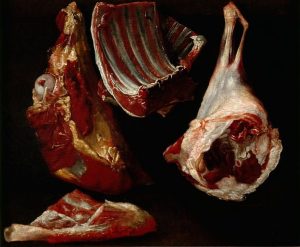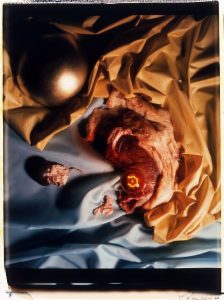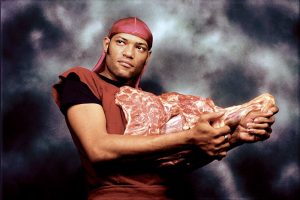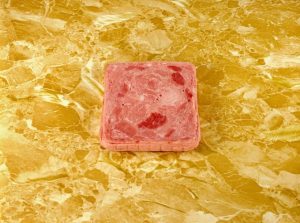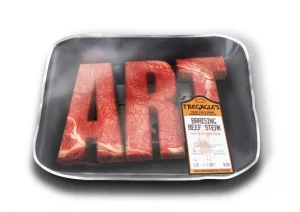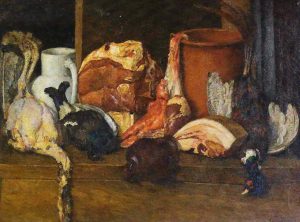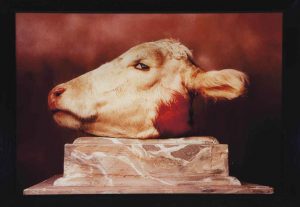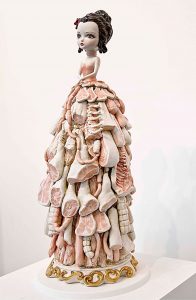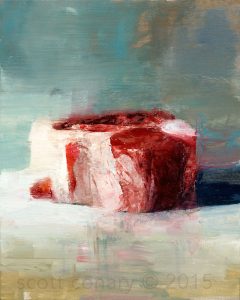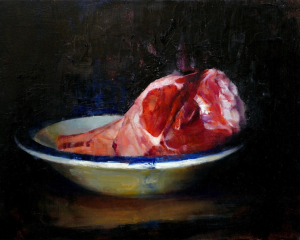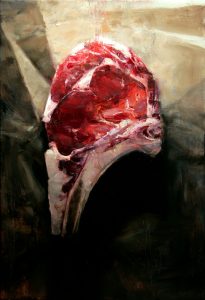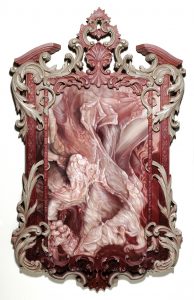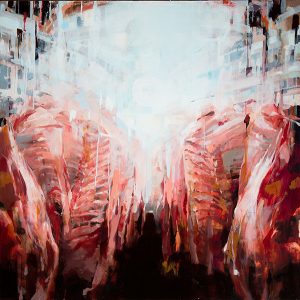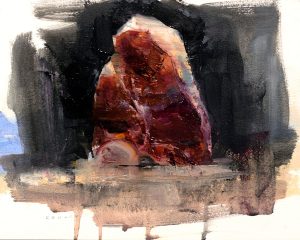Curators' Pick
Scott Conary | Lamb on Paper, 2023
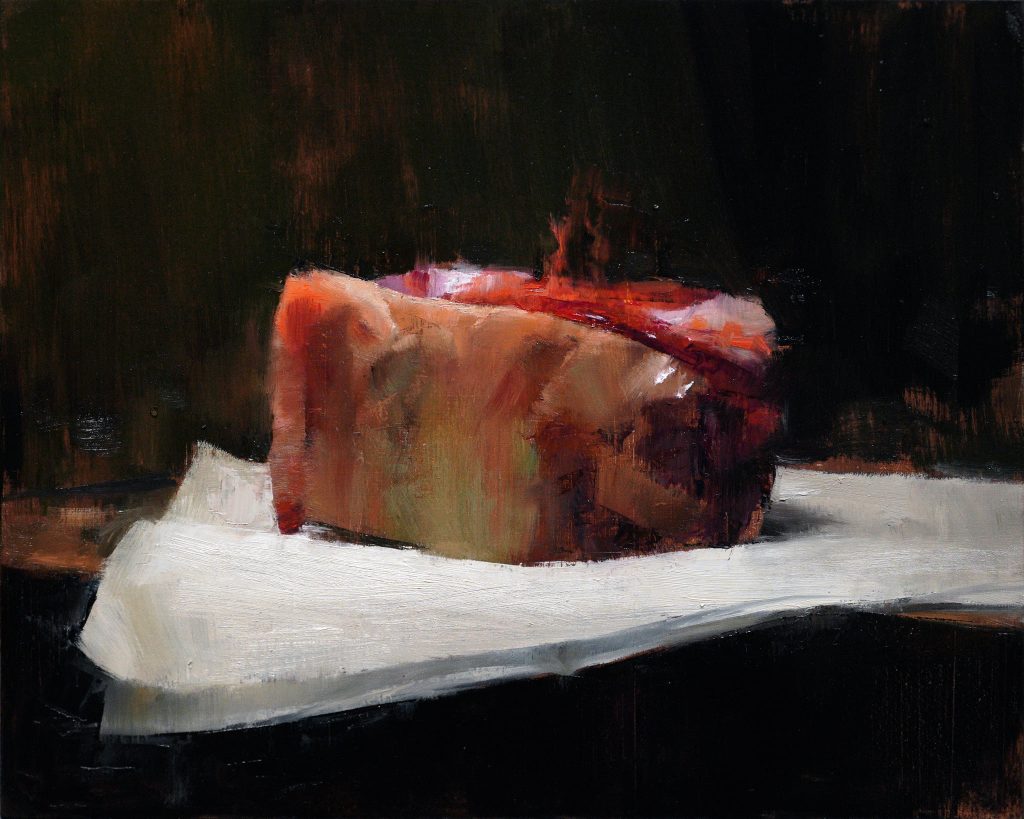
Scott Conary | Lamb on Paper, 2023
Flesh is our indisputable commonality. Whatever our race, our religion, our politics we are faced every morning with the fact of our bodies. Their frailties, their demands, their desires. And yet the erotic appetites that spring from – and are expressed through – those bodies, are so often a source of bitter dissension and division. Acts that offer a glimpse of transcendence to one group are condemned by another. We are pressured from every side – by peers, by church, by state – to accept the consensual definition of taboo; though so often what excites our imaginations most is the violation of taboo. (Clive Barker)
Meat, weeds, eggs, bottles, and bones. What began as a way to get back to the basics of painting, without an agenda, became something else. The meat paintings are, understandably, the pieces that elicit the most questions. The first is usually, “Why meat?” The glib answer is “you can only paint so many pears.” The longer answer is that the meat is beautiful and somewhat evocative. We have a much more complicated reaction to a hunk of lamb than we do to pepper. The meat is the stuff of us. We are, after all, meat. The smell shifts while I work. The color changes. I have vivid memories of meals with family and friends built around meat. It’s beautiful, desirable, and it’s unclean. (Scott Conary)
At a very young age I encountered Alina Reyes’ novel Le Boucher [The Butcher] : consider that your only warning, before you proceed.
Let us talk about meat, about the way of all flesh, about the grotesque and evocative history of painters and photographers offering us a sense of the sensual and the shocking.
Ah, but before we get to that I must say that when I encountered Scott Conary’s work on one of my social media feeds, I was struck by it’s beauty and execution (I was unsurprised it’s painted in oils, as there’s a sensuality to that medium) and it sent me on a deeper exploration of his works.
His words also acknowledge that this choice of subject matter is neither new nor to be eschewed. Many artists have employed this trope to investigate or confront larger issues: Chaïm Soutine’s Carcass of Beef, or Rembrandt van Rijn’s Slaughtered Ox, function both as still lives – though I might use the French term of nature morte, here – but also as metaphors, whether for religion, suffering, violence or our own ongoing obsession and repulsion with our own physicality.
- Attributed to Felice Boselli, Viandes de boucherie [Butcher meat]. c. 1600
- Helen Chadwick, Meat Abstract No. 8 : Gold Ball / Steak, 1989
- Andres Serrano, Meat Weapon, 1984
- Sandy Skoglund, Luncheon Meat on a Counter, 1978
- Marco Barneto, Meat Art, 2013
- Scott Conary, Cousin, 2015
Conary’s renderings of meat and flesh – like many of the artists whose works I’ve shared in this post – are inappropriately beautiful.
But that beauty is tendered by how it is often metaphor, as well. One of the works I share below by Ilya Mashkov, considering the date of its execution during the Russian Civil War, is a commentary that evokes the words of his contemporary, Boris Pasternak, where his character Zhivago, speaking to the local commissar (after examining a dying man) sardonically avers that “It isn’t typhus. It’s another disease we don’t have in Moscow…starvation.” Andres Serrano‘s Cabeza de Vaca references a Spanish ‘explorer’, presented as plunder instead of plunderer, and Mark Ryden’s Meat Dress offers something for us to visually consume that explores some of the same ideas as Jana Sterbak’s Vanitas: Flesh Dress for an Albino Anorectic (which I’ve written about before) but in a more palatable form, perhaps.
- Ilya Mashkov, Meat, poultry, 1924
- Andres Serrano, Cabeza de Vaca, 1984
- Mark Ryden, Meat Dress, porcelain sculpture, 2012
- Scott Conary, Ruby, 2015
- Scott Conary, Shank, 2022
- Scott Conary, Primer, n.d
Two more artists to share, that expand the conversation around Scott Conary’s meat works (I want to type that as one word – meatworks – as that seems more viscerally appropriate): Victoria Reynolds‘ art also offers “an uneasy tension between the understanding of flesh as food, and our self-identification of it; her conflation of desire, mortality, viscerality, and the survival instinct is a powerful source of aesthetic fascination.” Kanevsky, on the other hand, is primarily a figurative artist, as an American with heavy Eastern European influences. When you look at more of his work, and his preference for nudes, you may be forgiven for thinking that the work below is just painting the interior, instead of the exterior, of his ‘models’….
- Victoria Reynolds, Fat of the Lamb, 2003
- Alex Kanevsky, Interior With Meat, 2011
- Scott Conary, Last Stand, n.d
More of Scott Conary’s work can be seen here and his IG can be found here. His practice – and choice of subject matter – is quite varied (I was simply seduced by his meat works, if you will, but I did consider using his interpretations of eggs as a basis for a curator’s pick, as well) and worth exploring.
~ Bart Gazzola
